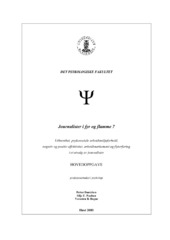Journalister i fyr og flamme? Utbrenhet psykososiale arbeidsmiljøforhold, negativ og positiv affektivitet, arbeidsnarkomani og flyterfaring i et utvalg av journalister
Master thesis
Permanent lenke
https://hdl.handle.net/1956/1775Utgivelsesdato
2001Metadata
Vis full innførselSamlinger
Sammendrag
The aim of this study was to examine burnout in a population of journalists (n = 209). Burnout was measured by The Maslach Burnout Inventory (Maslach et al., 1996). Ten percent of the journalists could be characterized as burned-out. The psychosocial work environment was measured by The QPSNordic (Skogstad, et al., 2001). The results indicated a strong relationship between burnout and the psychosocial work environment. According to Maslach and Leiter’s (1996) six areas of organizational life, there were mismatches on community and fairness, and to a lesser degree workload and control, which in turn were related to burnout. Negative and positive affect, measured by The PANAS Scales (Watson et al., 1988) accounted for some of the variance in burnout, and had mediating effects on the relationship between the psychosocial work environment and burnout. Workaholism as measured by Spence and Robbins’ measures of workaholism components (1992) showed some positive correlations to burnout. Flow as measured by The Flow State Scale (Jackson & Marsh, 1996) was to some degree negatively related to burnout. The importance of including personal and situational factors in the study of burnout is emphasized. Den foreliggende undersøkelsen kartlegger utbrenthet i et utvalg av journalister (n = 209). Ti prosent karakteriseres som utbrente. Maslach Burnout Inventory-General Survey (Maslach, Jackson & Leiter, 1996) måler utbrenthet. QPSNordic (Skogstad et al., 2001) kartlegger psykososiale arbeidsmiljøforhold. Utbrenthet er nært knyttet til psykososiale arbeidsmiljøforhold. Sett ut i fra seks psykososiale arbeidsområder, definert av Maslach og Leiter (1997), er fellesskap og rettferdighet sterkest relatert til utbrenthet. I tillegg er det en forbindelse mellom arbeidsmengde, kontroll og utbrenthet. Sammenhengen mellom psykososiale arbeidsmiljøforhold og utbrenthet påvirkes videre av negativ og positiv affektivitet, målt med The PANAS Scales (Watson et al., 1988). Arbeidsnarkomani er relatert til utbrenthet, og målt med Workaholism (Spence & Robbins, 1992). Flyt har en tendens til negativ sammenheng med utbrenthet. The Flow State Scale (Jackson & Marsh, 1996) måler flyt. Funnene understreker viktigheten av å trekke inn både individuelle og situasjonelle faktorer i studiet av utbrenthet.
Utgiver
The University of BergenOpphavsrett
Copyright the author. All rights reservedThe author
